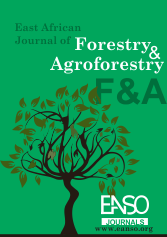Non-Tree Woody Plant Species Composition and Structure. A Case Study of Gidabwanja Forest Reserve (GFR) in Hanang’i District, Northern Tanzania
Abstract
The determination of non-tree woody plant species composition and structure was conducted at Gidabwanja Forest Reserve vegetation types in the Hanang'i district. Plots of 20 m x 20 m were established whereby shrubs and lianas were identified for their botanical names and counted for their individuals. RA and RD were calculated. A total of 40 non-tree woody plant species were identified during this study, and of those, 29 were shrubs, while 11 were woody climbers. Most non-tree woody plants were identified in bushland (34) followed by woodland (19), and the least number was recorded in shrubland. The calculated H′ at shrub land of 0. 352 implied low shrub and woody climbers diversity. The calculated mean H′ of 1.605 in woodland implied high diversity within this vegetation type. The calculated H′ mean of 1.607 from the overall total of 4.82 entails high diversity as the high H′ ranges from 3.5 ±1.5 or beyond but not exceeding H′ of 5 within the same growth forms of plants. The plant species with the highest RA is judged to be the most abundant within the specified locality. The plant species with the highest RD occupy the largest land size in the locality. The mean H′ of ≥1.5 of Gidabwanja Forest Reserve revealed high non-tree woody plant species. The non-tree woody plant species composition and structure are sampled in the established sample plots within the specified study area. Gidabwanja Forest Reserve has potential regarding vegetation species demanding high conservation attention. Further study is required to assess the conditions of all biological species in the Gidabwanja Forest Reserve and upgrade the forest reserve to a nature reserve, conservation awareness creation, and regular patrolling along the boundaries of the forest reserve.
Downloads
References
Aggemyr, E., Auffret, A.G., Jädergård, L., Cousins, S. O. (2018). Species richness and Composition differ in response to landscape and biogeography. Landscape Ecology,33: 2273–2284.
Engel, T., Blowels, S. A., McGlinn, D. J. Gotelli, N. J., McGill, B. J. & Chase, A. M. (2022). How does variation in total and relative abundance contribute to gradients of species diversity? Ecology and Evolution, 12 (8). https://doi.org/10.1002/ece3.9196.
Fischer, S., Greet, J., Walsh, C. J. & Catford, J. A. (2021). Food disturbance affects morphology and reproduction of woody riparian plants. Scientific Reports, vol. 11 No. 16477. https://doi.org/10.1038/s41598-021-95543-0.
Hou, P. J., Zhang, A. & Qi, N. (2020). Density peak clustering based on relative density Relationship. Pattern Vol.108, https://doi.org/10.1016/j.patcog.2020.107554.
Kent, M., & Coker, P. (1992). Vegetation Description and Analysis: A Practical Approach (pp.167-169). New York: John Wiley and Sons.
Kielak, A., Pijl, A. S., Johannes A. Van Veen, J. A. &Kowalchuk , G. A. (2008). Differences in vegetation composition and plant species identity lead to only minor changes in soil-borne microbial communities in a former arable field. FEMS Microbiology Ecology, Volume 63, Issue 3, March 2008, Pages 372–382, https://doi.org/10.1111/j.1574-6941.2007.00428.
Lefcheck, J. S., Edgar, G. J., Stuart-Smith, R. D., Bates, A. E., Waldock, C., Brandl, S. J., Kinimonth, S., Ling, S. D. Duffy, J. E. & Rasher, D. B. (2021). Species richness and identity both determine the biomass of global reef fish communities. Nat Commun12, 6875 (2021). https://doi.org/10.1038/s41467-021-27212-9ORCID: orcid.org/0000-0002-8787-17861.
Lin, H, Da Peddada, S. (2020). Analysis of compositions of micro-biomes with bias correction. Nature Communication, 11(1): 3514, DOI: 10.1038/s41467-020-17041-7.
Pablo Sanchez-Martinez, P., Mencuccini, M., García-Valdés, R., Hammond, W. M., Serra-Diaz, J. M., Guo, W., Segovia, R. A., Dexter, K. G., Syenning, J., Allen, C. & Martinez-Vilalta, J. (2023). Nature Ecology & Evolution. 7:1620–1632.
Parker, S. S., Harpole, W. S., Seabloom, E. W. (2019). Plant species natural abundances are determined by their growth and modification of soil resources in monoculture, 445: 273 -287, ORCID: orcid.org/0000-0002-9134-0742.
Liu, S., Frederic, B., Allard, D., Comar, A. (2017). A method to estimate plant density and plant Spacing heterogeneity: Application to wheat crops. Plant methods, 13 (1) DOI: 10.1186/s13007-017-0187-1.
Paz-Kagan, T., Chang, J. G., Shoshany, M., Sternberg, M. & Karnieli, A. (2021). Assessment of Plant species distribution and diversity along a climatic gradient from Mediterranean woodlands to semi-arid shrublands. 58:6,929-953, DOI: 10.1080/15481603.2021.1953770.
Schulz, B. K., Bechtold, W. A. & Zarnoch, S. J. (2009). Sampling and Estimation Procedures for The Vegetation Diversity and Structure Indicator. United States Department of Agriculture Forest Service Pacific Northwest Research Station General Technical Report PNW-GTR-781.
Setia, M. S. (2016). Methodology Series Module 3: Cross-sectional Studies. Indian Journal of
Dermatology, 61(3): 261–264. doi: 10.4103/0019-5154.182410
Shumi, G., Rodrigues, P., Hanspach, Hardtle, W., Hylander, K., Senbeta, F., Fischer, J. & Schultner, J. (2021). Woody plant species diversity as a predictor of ecosystem services in a social-ecological system of southwestern Ethiopia. Landscape Ecol36, 373–391. https://doi.org/10.1007/s10980-020-01170-x.
Wang, J., Soininen, J., Heino, J. (2021). Ecological indicators for aquatic biodiversity, ecosystem functions, human activities and climate change. Vol. 132.
Willis, K. (2019). Abrus schimperi (Burtt 1431). Digitised palynological slide. In African Reference Collection (Version 5, published 10/17/2019). Oxford Long-Term Ecology Laboratory.
Wilson, J. B., Peet, R. K., Dengler, J., Parte, M. (2012). Plant species richness: the World Records. Journal of Vegetation Science, 23 (4): 796 – 802.https://doi.org/10.1111/j.1654-1103.2012.01400.x.
Woodall, C. W., Weiskittel, A. R. (2021). Relative density of United States forests has shifted to higher levels over the last two decades with important implications for future dynamics. Scientific Reports11, 18848. https://doi.org/10.1038/s41598-021-98244-w.
Copyright (c) 2025 Canisius John Kayombo, Pamela Kessy, Phillipina Shayo

This work is licensed under a Creative Commons Attribution 4.0 International License.




























